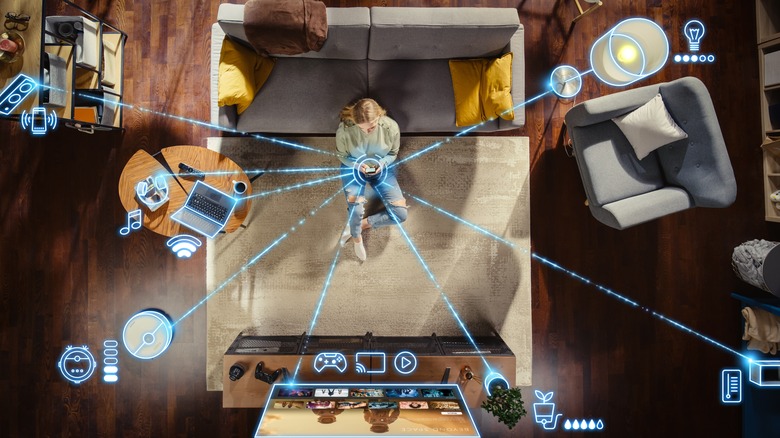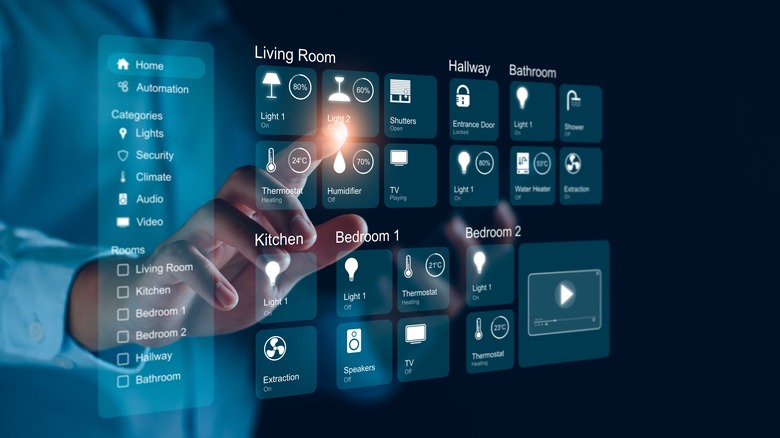
Gorodenkoff/Shutterstock
By Brad Hill/
So, you’ve decided you want to improve your life and embark on the journey of setting up a smart home. Having a disembodied voice assistant set reminders and recite the forecast for you is only the tip of the iceberg. There are many different capabilities and advantages to having a smart home. However, it’s important to know that it entails a lot more than merely swapping out old lightbulbs for ones that change colors.
Choosing all the different products you want is the easy part, and programming routines into your hub is time-consuming. It’s learning about the new protocols that improve compatibility between devices as well as the stability of your internet that’s the hard part. However, it’s just as crucial as choosing the ecosystem you want your smart home to be a part of. Before you take that first step of educating your home, here are a few things you want to know first.
Stable Wi-Fi is a must

Twenty-four_Photos/Shutterstock
Connectivity is, without a doubt, the most essential aspect of creating a smart home. If your devices can’t talk to each other, much less integrate with the internet consistently, a plan for building a network of smart devices is dead in the water. Many smart home devices can’t function properly without a connection to the internet.
Home assistant devices require a stable internet connection if you want them to give weather updates or conduct quick Google searches. If Wi-Fi in the home is patchy, the smart devices become unresponsive and fail to conduct the roles they’re assigned to accomplish. Something as easy as dimming lights could be a challenge.
Causes for unreliable internet typically come down to the internet speed you’re paying for, but it could be as simple as the position of your router. If internet connectivity is an issue throughout the house, consider investing in a wi-fi extender or mesh network, depending on the cause of the issue. On top of having stable internet for the house, your smart home devices should be on a different wi-fi network.
Compatibility matters

LALAKA/Shutterstock
From Apple to Samsung, there is no shortage of brands that manufacture smart devices for the home. Unfortunately, not every brand makes every little device you need for your home. You might have an Apple HomePod for a smart speaker, but Apple doesn’t manufacture TVs, meaning your smart TV has to come from a different company. This can pose compatibility issues.
This requires stepping out of a pre-determined ecosystem and investing in other brands. Luckily, Matter, a joint initiative between multiple tech companies to unify smart devices, makes everything easier. Once upon a time, users had difficulty finding a smart bulb that worked with the hub of their choice. If you used an iPhone but your partner had an Android, it was even more challenging to find some cohesion.
Matter improves interoperability between devices, making it possible to sign in to only one app to control the entirety of your smart home. While there’s a wide variety of devices from multiple brands that operate on Matter’s system, not every device does. It’s important to ensure whichever product you buy supports Matter.
Don’t do everything at once

wut62/Shutterstock
It’s easy to get swept up in the excitement of creating a home that automates your daily tasks. Who doesn’t want to control the ambient lighting in their living room while simultaneously asking Alexa to order more cat food and batteries for you? However, not only is it expensive, it’s overwhelming. Start small and build your smart network brick by brick.
Start with the essentials like a smart speaker. This will not only give you a trusty voice assistant to call on when needed, but it will also give you an idea of which ecosystem you want to build your smart home around. The primary options most go with are Apple, Alexa, and Google, but Samsung’s SmartThings isn’t a terrible option.
It’s not necessary to buy a speaker with a screen right away. As convenient as it is to have visuals, it’s more affordable to go with the speaker-only option first. Once you have your voice assistant installed and you’ve acclimated to its features, you can branch out to other smart devices. From smart locks and smart lighting to thermostats and video doorbells, you can have your entire house seamlessly work together to make your life easier.